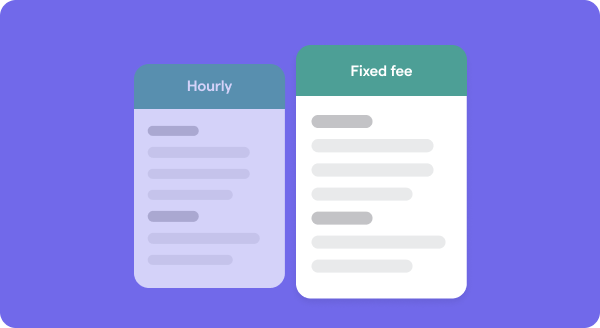Expert webinar insights on fixed-fee billing for accountancy services

From movie streaming services to SaaS software platforms, subscription and fixed-fee billing has redefined how people think about value – and how it’s priced.
But can subscription and fixed-fee billing pricing be used by CPA firms?
The short answer is absolutely.
Today's accounting landscape calls for more transparency, consistency, and value.
A fixed or flat-fee billing model (which sometimes takes the form of a subscription) are common pricing strategies that enable you to simplify client engagements and stabilize your firm's revenue streams.
Our latest webinar, “Unpacking the pricing dilemma”, dives into the topic of pricing for CPA firms. Here’s a top level overview of the main points discussed.
Key takeaways
It’s time to reconsider hourly pricing or hourly rates when pricing accounting services.
A fixed fee offers clear, upfront pricing, which leads to more transparency and predictability in accounting services costs.
Be very intentional with your engagement letters or accounting service agreements.
When coming up with pricing plans and subscriptions, be upfront about the specific tasks and accounting services included in the engagement. This will help prevent scope creep.
Be mindful of how you communicate your new pricing structures.
Implement a thoughtful communication strategy when informing clients about your pricing. Rather than springing it on them abruptly or sending an impersonal email, have a conversation about the value you provide.
Just do it.
Pricing conversations tend to be awkward. There’s no way around them, so the best thing to do is to face these discussions head on.
Systematize renewals and price increases.
You’ll need to increase your prices over time. Make this process easier by doing it regularly (ideally annually) through contract renewals or service agreement updates.
Ignition can help you implement the right billing structure.
Whether you’re implementing hourly, fixed, or subscription-based billing, Ignition has got you covered. The platform empowers businesses to get paid faster, and run smarter. With it, you can craft your pricing and agreements based on your firm's unique needs and client preferences.
Moderated by Ryan Embree, Director of Partnerships (AMER) at Ignition, the webinar features an insightful panel discussion with four seasoned accounting firm owners:
- Clayton Achen, Achen Henderson CPA.
- Michelle Vilms, Vilms Consulting.
- Jeremy Wells, JWellsCFO.
- Anne Napolitano, Anne Napolitano Consulting.
The panelists had a lively conversation about the rewards of transitioning to a flat fee or subscription model and discussed practical steps on how accounting professionals can move from the traditional hourly billing model to fixed fee pricing and subscriptions.
They also provided practical guidance for the many accounting firms who want to make the switch.
Watch the on-demand webinar: Unpacking the pricing dilemma

Breaking down the fixed fee or subscription pricing model
What exactly does a fixed price or subscription fee model entail when billing clients?
According to Clayton Achen, the fixed billing model is all about bundling different bookkeeping and accounting services and offerings.
For example, accounting software, financial statements, bookkeeping services, tax planning – into a flat free.
He says his accounting firm generally operates using a fixed-fee structure, though there may still be a variable aspect depending on the job.
“We have a core compliance business where we bill a flat fee, but there's a variable component that we include, and we bill most of it at the end of the job. We still do that for a lot of our compliance department,” he says.
Jeremy Wells, for his part, uses a subscription billing model, through which his clients gain a certain level of access to him and his team for a flat monthly fee.
He likens it to Netflix’s business model, which allows subscribers to access its content library on-demand, for one straightforward monthly rate.
“If it's in Netflix’s library, you can watch it, and that's what you're paying for. You're not paying for the specific movies or shows that you watch. You're paying for access to that entire library,” he explains.
Related ebook: Mastering your pricing strategy for tax season
Preventing scope creep in your accounting firm
One of the potential challenges of fixed fee billing is the risk of scope creep.
The best way to prevent it, says Jeremy Wells, is to be clear and upfront in your engagement letter and scope.
“The way you prevent scope creep within the subscription model is to be very clear, intentional, and precise about what actually is included,” says Jeremy Wells.
Anne Napolitano adds that when crafting your engagement letter or service agreement, make sure the scope of work is well-defined and documented.
Both parties should understand and agree on what’s included in the fixed-fee and what would constitute additional work.
“The engagement letter should be very clear about what you're going to do and the expectations,” she says.
“I've gotten to the point where I'm very mindful of my engagement letters and my scope. I strive to define everything in order to make this subscription model work. And it works great, but it requires that thought process,” says Anne Napolitano.

How to communicate your new pricing to clients
Once you’ve decided to ditch hourly billing, how should you tell your clients that you’re fundamentally changing how you do business?
Communication is perhaps the most challenging part of transitioning to a new pricing structure.
According to Michelle Vilms, it’s best to be direct.
Let your clients know that you’ve evaluated your operations and you’ve decided to implement a new pricing structure. Then, invite them along for the journey.
“While that is an uncomfortable conversation, we have gotten paid on those by being honest and asking for what we need,” says Michelle Vilms.
Still feeling awkward?
See if you can start these conversations with clients that you already have a strong relationship with, adds Anne Napolitano.
“The relationship you develop with your clients allows you to have those great kinds of conversations where there's mutual benefit for each other.”

Jeremy Wells brings up an alternative approach wherein you establish a separate entity with your new pricing and business model.
When you have a new accounting firm in place, you can focus on communicating your value pricing to prospective clients, rather than spending too much time training existing clients and staff.
He says this is a good approach to take if you want to try a different pricing model without rocking the boat in your existing firm. Now, if you find that new strategy doesn’t work for you, you can go back to how you were doing things before.
As Jeremy puts it, "You can always retreat back to your old firm if things don’t work out.”
Related ebook: Best practice guide: Mastering client communications
Steering client conversations on renewals and price adjustments
How do you talk to clients about renewals and pricing increases?
As with any conversation concerning price, the topic of renewals and price increases can be awkward.
Michelle Vilms says the best approach is to incrementally increase your prices, ideally on an annual basis.
She also recommends having pricing meetings before sending any renewal documents.
This gives you the opportunity to see where your clients are, address any concerns, and explain the value you bring to the table.

In the same vein, Anne Napolitano says that, “On-going touchpoints have made these conversations easier, because the clients see the value of what you’re doing.”
Clayton Achen adds that his main advice is to simply go for it.
“Just do it”, he says.
He recommends thinking about how you're positioning your message and what the benefits are for your customer.
What's the benefits to re-engaging annually? There's all kinds of reasons why you should be doing it more frequently, says Clayton Achen.
“I think just get over your fear and go with it. And if some clients give you pushback, explain to them what the value is to them, and if they still give you pushback, goodbye,” he says.
Register now: Join us for our upcoming webinar on Renewing clients, or time to let go? (1.0) CPE, on November 29 at 2pm ET.
Where to from here?
It’s time to switch from hourly rates to fixed fee billing or subscription.
Doing so enables you to implement value-based pricing, where the focus shifts from the time spent on a task to the actual value and outcomes you deliver to your clients.
Making the transition isn’t easy, but it’s completely doable when you have a solid client relationship and a communication strategy that conveys clear client benefits.
Ready to ignite your pricing strategy?
Whether you’re implementing fixed-fee billing or have clients paying your hourly rate, Ignition can help you set the right expectations with automated engagement letters that outline your services, pricing, billing frequency, and engagement terms. All in one easy-to-sign online proposal.
Set-and-forget client billing and automatic payment collection then takes the hassle out of getting paid and helps protect your cash flow. Watch our on-the-spot demo to learn more.
